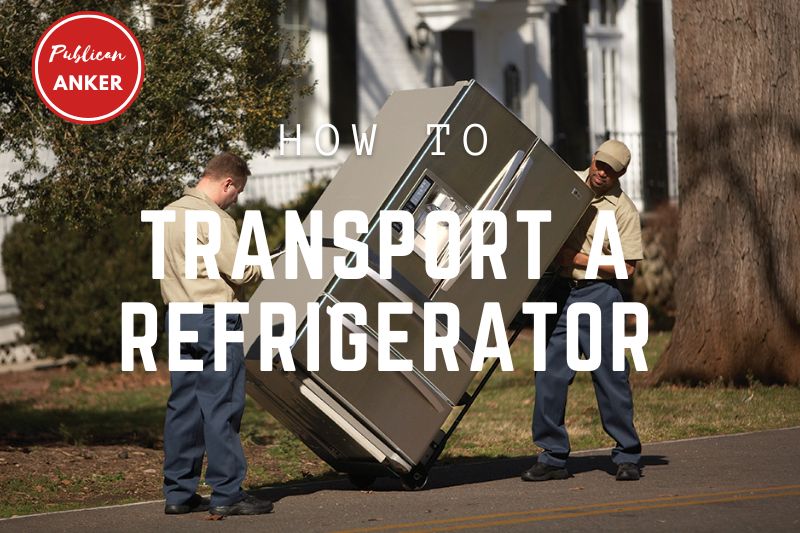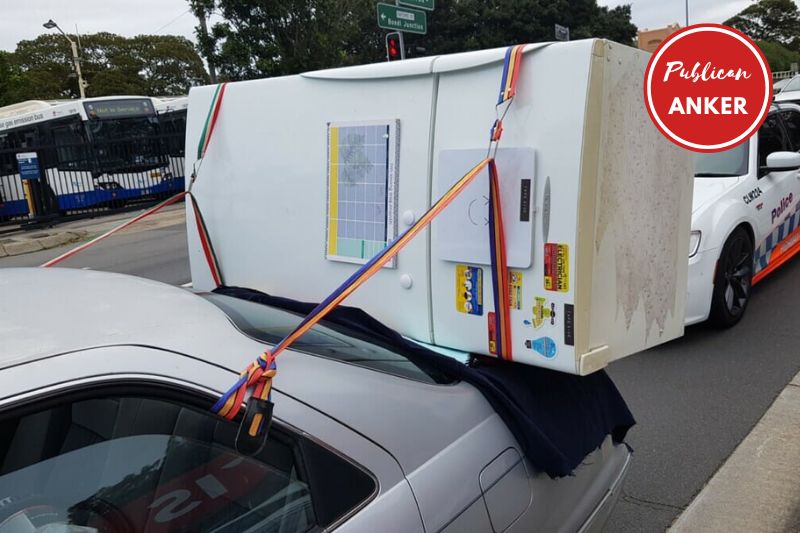Transporting a refrigerator can be daunting, especially if you have never done it before. Whether you’re moving to a new home or simply need to transport your refrigerator for repairs, proper handling is crucial to avoid any damage to the appliance or injury to yourself.
In this guide, we will take you through the step-by-step process of how to transport a refrigerator safely and efficiently. We will provide practical tips and advice on how to prepare the fridge for transport, how to move it without damaging it or your home, and what precautions to take during hauling a refrigerator.
What Tools Do You Need to Move a Refrigerator?
Moving a refrigerator is a challenging task that requires careful planning and preparation. To ensure the safety of yourself and your appliance, it’s essential to have the right tools and equipment. This article will discuss the tools you need to move a refrigerator.
Moving Dolly
A refrigerator moving dolly is a hand truck designed to move heavy objects. It has two wheels and a platform where the refrigerator can be placed. The easy way to move fridge is usually padded to prevent scratches or damage to the appliance.
A moving dolly makes it easier to transport a refrigerator, especially if you have to move it up or down stairs or moving fridge short distance. Secure the refrigerator with straps or ropes to prevent it from falling off when using a moving dolly and.
Furniture Sliders
Furniture sliders are pads made of plastic or rubber that are placed under the refrigerator’s feet. They make sliding the refrigerator across the floor easier without scratching or damaging it. Furniture sliders are the best way to move a refrigerator and especially useful if you move a fridge by yourself on a hard surface like a tile or hardwood floor.
Appliance Strap
An appliance strap is a heavy-duty strap that secures the refrigerator to the moving dolly or truck. It helps prevent the refrigerator from falling off or shifting during shipping a refrigerator on its side. The appliance strap should be tight enough to hold the refrigerator in place but not so tight that it damages the appliance.
Tape Measure
A tape measure is essential when moving a refrigerator. You’ll need to measure the refrigerator’s dimensions to ensure it will fit through doorways, hallways, and staircases. Measuring the space where the refrigerator will be placed in the new location is also helpful to ensure it fits properly.
Screwdriver
A screwdriver is needed to remove any refrigerator parts that may need to be taken off for transport. For example, you may need to remove the doors, shelves, or drawers to make the refrigerator lighter and easier to move. Keep all screws and parts safe to easily reassemble the refrigerator later.
Moving Blankets
Moving blankets protect the refrigerator from scratches or damage during transport. They’re usually made of thick, heavy-duty material and can be wrapped around the refrigerator to provide extra protection as well as help moving a fridge across the room.
Moving blankets are especially useful if the refrigerator will be transported in a truck or trailer, where it may shift during transport.
Gloves
Wearing gloves is essential when moving a refrigerator. They provide extra grip and protect your hands from cuts and scrapes. Gloves made of thick, durable material are recommended.
How to Transport A Refrigerator
Transporting a refrigerator can be a challenging task, but with proper planning and execution, it can be done safely and efficiently. In this guide, we will take you through the process step by step to ensure that your refrigerator arrives at its destination in good condition.
1. Clean out and defrost the unit
Before transporting your refrigerator, it’s important to clean out the contents and defrost them. This will prevent any water damage during the move and keep your fridge fresh and ready to use when you arrive at your new location.
Start by emptying the contents of your fridge and freezer, including any perishable items. Dispose of any items that may spoil during the move and any expired or unwanted food items.
Next, defrost the refrigerator according to the manufacturer’s instructions, which may involve turning off the unit and leaving the doors open for a few hours until all the ice has melted.
Once the fridge is defrosted, wipe down the interior with a clean towel or cloth to remove any moisture. This will help prevent any mold or mildew from growing inside the unit during transport.
2. Disconnect the fridge according to the user manual
After the fridge is cleaned and defrosted, it’s time to disconnect it from the power source. Before doing so, consult the user manual to ensure you follow the proper procedure for your specific model.
Typically, this involves unplugging the fridge from the electrical outlet and disconnecting any water supply lines if applicable. Be sure to turn off the water supply valve and carefully disconnect the line to avoid leaks or spills.
3. Measure the fridge and doorways to create a moving plan
Before you start moving the refrigerator, it’s essential to plan out the logistics of the move. Measure the fridge and the doorways of both the old and new locations to determine the best way to move the unit.
Take note of any narrow doorways or tight corners that may require extra maneuvering. Measure the fridge’s height, width, and depth to ensure that it will fit through all the doorways and hallways along the way. This information will help you determine the best path to move the refrigerator.
4. Remove obstacles like doors as necessary
If the fridge is too large to fit through a doorway or hallway, you may need to remove any obstacles. This could involve removing a door or temporarily taking apart a piece of furniture to create more space.
If you remove a door, store it safely and securely to avoid any damage during transport. Label any removed pieces to make it easier to reassemble them later.
5. Slide the fridge out and strap it onto the dolly
Once the path is clear, it’s time to move the refrigerator. Begin by sliding the fridge out of its current location and onto a sturdy dolly. It’s essential to use a rated dolly to handle the weight of your fridge and to strap the unit securely onto the dolly to prevent it from tipping over.
To secure the fridge, wrap the straps around the body of the refrigerator and tighten them until the unit is snug against the dolly. Be careful not to overtighten the straps, as this could damage the fridge.
6. Tilt the fridge back and move slowly with care
With the fridge securely strapped to the dolly, it’s time to move it to the truck. Tilt the fridge back slightly onto its wheels and move slowly, keeping the unit constantly balanced.
If you’re moving the refrigerator up or down any stairs, take extra care to ensure that the unit doesn’t tip over or slide off the dolly. Move slowly and carefully, taking breaks as needed to avoid straining yourself or causing any damage to the fridge.
7. Guide the fridge into the moving truck
When you reach the moving truck, carefully guide the dolly and refrigerator up the ramp and into the truck. Use caution when going over the threshold of the truck, as this can be a tricky spot where the refrigerator may get stuck. Once inside the truck, position the fridge securely and ensure it won’t shift or tip during transport.
8. Secure the refrigerator for the move
Finally, it’s time to secure the refrigerator for the move. Use moving blankets or padding to wrap the fridge and protect it from scratches or damage. Use ropes or straps to secure the fridge to the truck’s walls or floor, ensuring it’s anchored securely and won’t move during transport.
Why Should You Not Tip a Refrigerator?
When moving a refrigerator, it’s important to handle it carefully to avoid any damage or injury. One common misconception is that it’s necessary to tip the refrigerator to move it, but this can actually cause more harm than good. Here are some reasons why you should not tip a refrigerator:
Risk of Damage
Tipping a refrigerator can cause damage to the appliance and the surrounding area. When you tilt the fridge, the weight shifts, putting pressure on the components inside. This can cause the fridge to become unbalanced, leading to dents, scratches, or even a damaged compressor.
Additionally, tipping the refrigerator can cause it to scrape against the floor or walls, causing damage to the surrounding area.
Safety Hazards
Tipping a refrigerator can also pose safety hazards. The appliance is heavy and bulky, making it difficult to control when it’s tilted. If the fridge falls over or tips too far, it can cause serious injury to anyone nearby. This is especially true if the fridge is not secured properly, as it can slide off the dolly or ramp and cause harm.
Unnecessary
Tipping a refrigerator is simply unnecessary. There are other ways to move the fridge safely without tilting it. For example, you can use a dolly or lift to move the fridge without risking it. Additionally, you can remove the doors or disassemble the fridge to make it easier to transport.
Potential Damage to the Cooling System
Tipping the refrigerator can cause damage to the cooling system. When the refrigerator is tilted, the refrigerant inside can shift and create air pockets. This can cause the compressor to work harder and potentially overheat, leading to a breakdown of the cooling system.
How to Transport a Fridge Down Stairs?
Here are some steps which is the best way to transport a refrigerator downstair safely:
Clear the way
Before moving the fridge, ensure the pathway is clear of any obstacles. Remove any items or furniture that may obstruct the way down the stairs. This will ensure that you have enough space to move the fridge safely.
Secure the fridge
Wrap the fridge in moving blankets or padding to protect it from scratches and damage. Use straps or ropes to secure the fridge to a moving dolly or hand truck. Ensure the fridge is tightly secured to the dolly and the straps or ropes are tightened to keep it in place.
Gather a team
Moving a fridge downstairs can be a two-person job or more, depending on the size and weight of the appliance. It’s best to have a team of at least two people to help with the move. Ensure everyone wears sturdy shoes and has a good grip on the dolly.
Plan the route
Measure the stairs and the fridge to ensure they fit through the staircase. Plan the route and decide who will lead and be at the back of the dolly. Walk down the stairs first to identify any obstacles or narrow spaces.
Move the fridge down the stairs
Carefully move the fridge down the stairs one step at a time. Ensure that the person leading the dolly has a clear view of the stairs and is guiding it slowly. The person at the back should support the fridge’s weight and help keep it stable.
Watch out for corners and landings
When you reach corners and landings, be extra cautious. These areas may require additional effort to move the fridge around the turn or down the landing. Keep the dolly as close to the stairs as possible to prevent it from tipping.
Check the path ahead
Before continuing down the stairs, check the path ahead to ensure it’s clear of any obstacles. Watch out for any changes in the surface of the stairs or any unevenness that may cause the dolly to tip.
Place the fridge in the moving truck
When you reach the bottom of the stairs, guide the dolly and fridge into the moving truck. Make sure to place the fridge securely and use ropes or straps to anchor it to the walls or floor of the truck.
Tips For Moving A Refrigerator?
Moving a refrigerator can be daunting, but with the right approach, it can be done smoothly and safely. Here are some tips for moving a refrigerator:
Plan Ahead
Before you start moving the refrigerator, plan. Measure the dimensions of the refrigerator and the doorways, hallways, and staircases that you’ll need to navigate to get it out of your house. Plan your route and make sure there are no obstacles in the way. If you’re moving to a new home, measure the space where you want to put the refrigerator to make sure it will fit.
Empty the Refrigerator
Empty the refrigerator and defrost it for at least 24 hours before moving it. This will prevent leaks and make the refrigerator lighter and easier to move. Dispose of any perishable items, and clean the interior of the refrigerator.
Gather the Right Tools and Equipment
Moving a refrigerator requires the right tools and equipment. You’ll need a moving dolly, furniture sliders, an appliance strap, a tape measure, a screwdriver, moving blankets, and gloves. Make sure you have everything you need before you start moving the refrigerator.
Secure the Refrigerator
Before you start moving the refrigerator, secure it with an appliance strap. This will prevent it from shifting or falling off the moving dolly during transport. Be sure to tighten the strap enough to keep the refrigerator in place but not so tight that it damages the appliance.
Use a Moving Dolly
A moving dolly is essential for moving a refrigerator. It makes it much easier to transport the refrigerator, especially if you have to navigate stairs or uneven surfaces. Secure the refrigerator on the moving dolly with the appliance strap.
Protect the Refrigerator
Wrap the refrigerator in moving blankets to protect it from scratches and damage during transport. The blankets will also provide extra cushioning if the refrigerator shifts during transport.
Use Furniture Sliders
Furniture sliders can make moving the refrigerator across the floor easier, especially if you’re moving it on a hard surface like tile or hardwood. Place the sliders under the refrigerator’s feet and slide them across the floor.
Be Careful When Moving the Refrigerator
Moving a refrigerator can be hazardous, so it’s important to take precautions. Ensure you have a clear path to move the refrigerator and be aware of any obstacles or hazards. If you’re moving the refrigerator up or down stairs, have someone help you to prevent it from falling or slipping.
Reassemble the Refrigerator
Once you’ve moved the refrigerator to its new location, reassemble it. Replace any parts you have removed for transport, like doors, shelves, or drawers. Plug in fridge after moving and wait an hour before putting any food back in it.
How Long to Let A Refrigerator Sit After Moving It?
The general rule of thumb is to let the refrigerator sit for at least 2 to 3 hours before plugging it in. This allows the compressor and other internal components to settle after being moved, which can help prevent damage or malfunctions.
However, suppose the refrigerator was transported upright and not tilted or turned over during transport. In that case, it may be safe to start refrigerator after moving using it immediately. It’s always a good idea to consult the manufacturer’s instructions or user manual for specific recommendations on how long to let your refrigerator sit after moving it.
In addition to letting the refrigerator sit before plugging it in, it’s also important to ensure its level before using it. Use a level to check that the refrigerator is balanced, and adjust the feet or leveling screws as needed to ensure that it’s stable and won’t wobble or tip over.
Read more:
- How To Remove Ice Maker From Samsung Refrigerator 2023
- How To Build A Refrigerator Cabinet Top Full Guide 2023
FAQs
Can you plug in a fridge after moving it?
Yes, you can plug in a fridge after moving it, but it’s recommended to let it sit for at least 2 to 3 hours before turning it on. This allows the internal components to settle after being moved, which can help prevent damage or malfunctions.
However, suppose the refrigerator was transported upright and not tilted or turned over during transport. In that case, it may be safe to plug it in and start using it immediately.
How long to wait to turn on fridge after moving?
It’s recommended to wait for at least 2 to 3 hours before plugging in fridges after moving. This allows the internal components to settle after being moved, which can help prevent damage or malfunctions.
Can modern refrigerators be transported on their side?
No, modern refrigerators should not be transported on their side. This is because the compressor and other internal components are designed to operate upright, and tilting the refrigerator can cause damage or malfunctions.
If the refrigerator needs to be transported on its side, it should be laid flat and secured with straps or other restraints to prevent it from shifting or tipping over during transport.
It’s always a good idea to consult the manufacturer’s instructions or user manual for specific refrigerator transport recommendations.
What are Samsung refrigerator moving instructions?
- Empty the fridge of all food and drinks.
- Turn off the power and unplug the fridge.
- Remove any shelves, drawers, and other loose parts and pack them separately.
- Secure the doors with tape or rope to prevent them from opening during transport.
- If you need to lay the fridge on its side, do so for as short a time as possible and then allow it to stand upright for at least 4-6 hours before plugging it in and turning it on.
- Use a dolly or hand truck to move the fridge, and take care not to damage the flooring.
- When you arrive at your destination, allow the fridge to stand upright for several hours before plugging it in and turning it on.
Conclusion
To sum up, moving a refrigerator can be challenging, but with proper planning, equipment, and precautions, it can be done successfully.
It’s important to empty and defrost the refrigerator before moving it, gather the right tools and equipment, secure it with an appliance strap, use a moving dolly and furniture sliders, protect it with moving blankets, and be careful when moving it. With these tips of how to carry a fridge in mind, you can ensure your refrigerator’s safe and smooth mini fridge transport.
On a different note, if you’re interested in high-quality audio equipment, I recommend checking out Publicananker. They offer a range of wireless headphones and microphones that are perfect for music production, podcasting, and live streaming.









